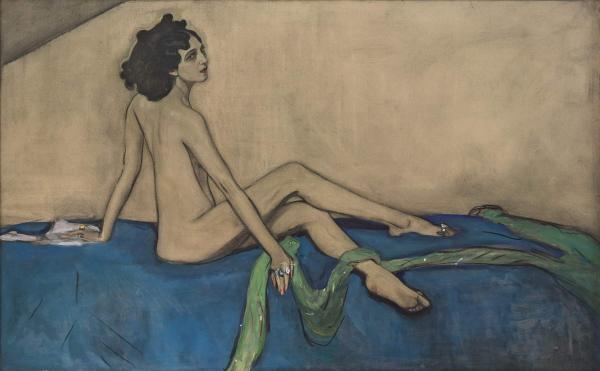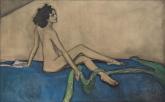Ida Rubenstein
1910
- Period Late 19th century – Early 20th century
- CategoryPortrait
- Share
Valentin Serov’s portrait of Ida Rubinstein is one of the finest examples of Russian Art Nouveau painting. The stylistics are dictated by the dancer’s physical appearance and the nature of her art, conjuring up images of oriental history.
Ida Rubinstein (1880–1960) was famous in Paris for her performances of the roles of Zobeïde in Schéhérazade and Cleopatra in Cléopâtre. Both ballets were choreographed by Mikhail Fokine for Sergei Diaghilev’s first two Saisons Russes in 1909 and 1910. Valentin Serov painted this portrait in Paris in summer 1910. Russian Museum: From Icons to the Modern Times. Palace Editions, St Petersburg, 2015. P. 263.
Ida Lvovna Rubinstein (1880–1960): Ballet dancer. Studied under Alexander Lensky and Mikhail Fokine. Danced in Sergei Diaghilev’s first two Saisons Russes in Paris. Founded her own company (1928–35).
Painted a year before the artist’s untimely death, Valentin Serov’s portrait of Ida Rubinstein is an outstanding example of Style Moderne (Russian Art Nouveau). The stylistics of the work are dictated by the sitter’s character and physical appearance. Russian ballet dancer Ida Rubinstein was famed for her performances in Sergei Diaghilev’s productions of Cléopâtre and Schéhérazade in Paris. The dancer’s figure and style of dancing seemed to transport the viewer back to ancient times. Valentin Serov exclaimed: “Every move she makes is monumental; an archaic bas-relief come to life.” The picture was painted in Paris in the summer of 1910. Rubinstein posed naked, like the patricians who posed for Titian. The master likened his heroine to an Assyrian relief, flattening the forms of her body and outlining them with an expressive contour. The sharp silhouette and the refined spicy tones intensify the psychological characteristics. Serov depicts Rubinstein wearing the tragic expression of her eyes and mouth that he called her “wounded-lioness look”. The allusions to the volumes of the face, shoulders and legs are masterful. The game of contrasts between psychologism and decoration, three-dimensionality and flatness, asceticism and acerbity, was typical of Art Nouveau painting.

